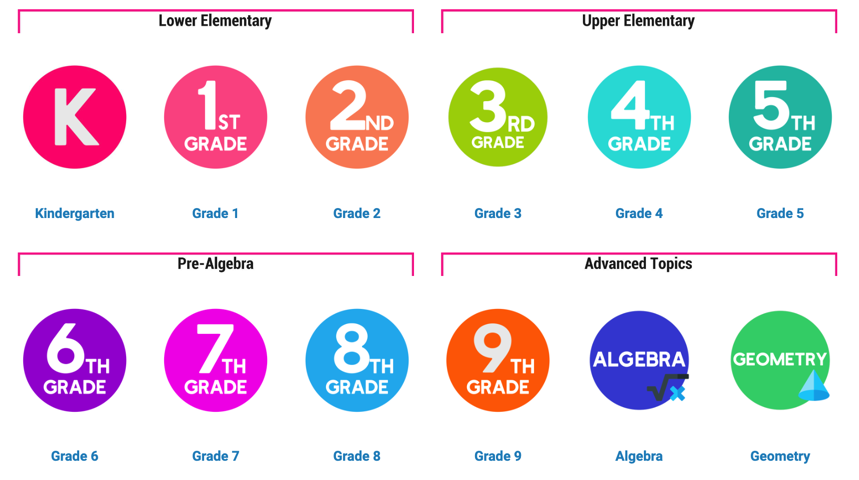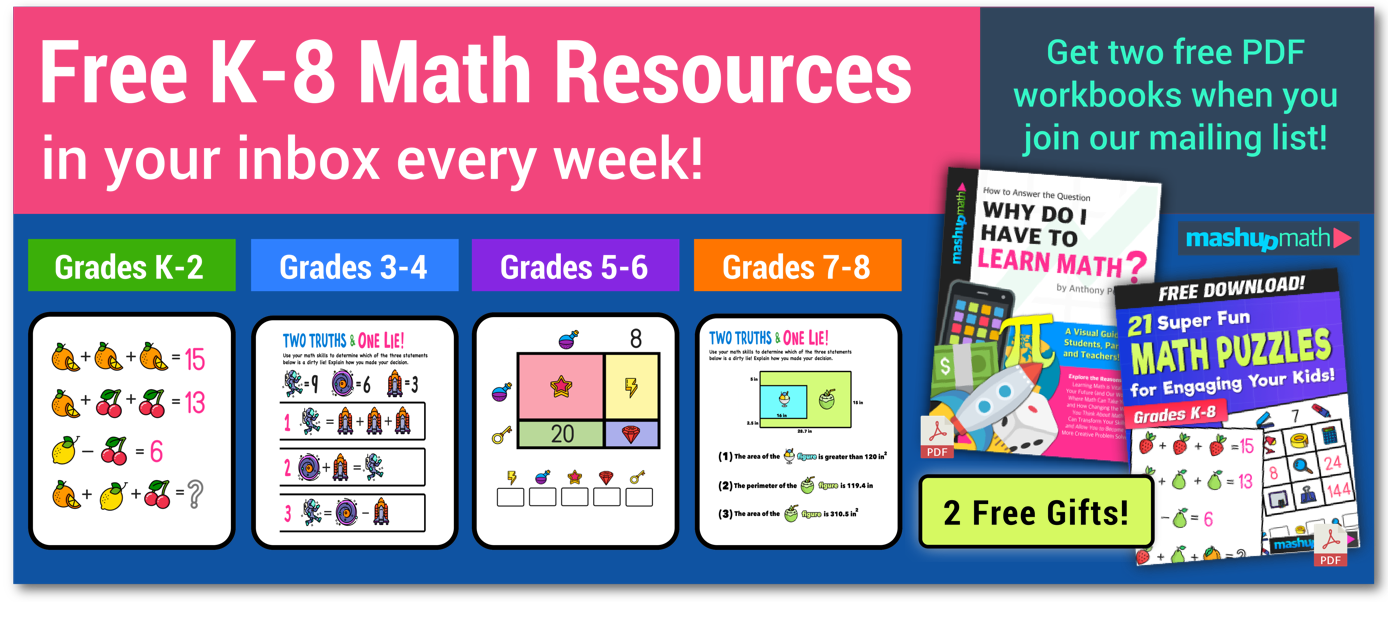Math Addition Worksheets
Free Addition Worksheets Library for Grades K-4 (with Answer Keys)
Welcome to this free library of math addition worksheets from Mashup Math!
You can use the quick-links below to jump to any section of this library of addition worksheets for students in grades K-4:
Each addition worksheet is available as a printable PDF download that includes a complete answer key.
To download any of the free addition worksheets below, simply click on any of the blue text links to access the PDF file. You can also preview several of the worksheets by clicking on the preview image boxes at the top of each section.
In addition to our free addition worksheets, this page also includes a short review of simple addition that you and your students can reference if they need help with adding or with completing a particular addition worksheet.
Note that all of the free math addition worksheets in the library below are sample activities from the Mashup Math K-12 Worksheet Libraries available on our website. | Quick Links: How to Download/Print
Simple Addition Worksheets
Add Using Fingers
Click Image to Preview
Adding Two
Click Image to Preview
Simple Addition
Click Image to Preview
Single Digit Addition Worksheets
Add to Make 10
Click Image to Preview
Vertical Addition
Click Image to Preview
Fill in the Missing Number
Click Image to Preview
Advanced Addition Worksheets and Word Problems
Vertical Addition
Click Image to Preview
Adding Whole Hundreds
Click Image to Preview
Word Problems
Click Image to Preview
▶️ Vertical addition to 100 (A)
▶️ Vertical addition to 100 (B)
▶️ Addition: fill in the missing number (up to 20)
▶️ Addition: fill in the missing number (up to 100)
▶️ Adding double-digit numbers (A)
▶️ Adding double-digit numbers (B)
▶️ Adding triple-digit numbers
▶️ Adding one and two-digit numbers (A)
▶️ Adding one and two-digit numbers (B)
▶️ Adding whole tens (3 addends) (A)
▶️ Adding whole tens (3 addends) (B)
▶️ Adding whole hundreds (2 addends) (A)
▶️ Adding whole hundreds (2 addends) (B)
▶️ Adding whole hundreds (3 addends) (A)
▶️ Adding whole hundreds (3 addends) (B)
▶️ Adding two four-digit numbers (vertical)
▶️ Adding three four-digit numbers (vertical)
▶️ Complete whole thousands (A)
▶️ Complete whole thousands (B)
▶️ Adding 4-digit numbers (vertical)
▶️ Adding 5-digit numbers (vertical)
▶️ Adding 5 and 6-digit numbers (vertical)
▶️ Adding 3 numbers in columns (A)
▶️ Adding 3 numbers in columns (B)
▶️ Adding 4 numbers in columns (A)
▶️ Adding 4 numbers in columns (B)
▶️ Adding 5 numbers in columns (A)
▶️ Adding 5 numbers in columns (B)
▶️ Addition word problems (single-digit)
▶️ Addition word problems (2-digit) A
▶️ Addition word problems (2-digit) B
🛑 HOLD ON! Do You Want More FREE Topic-Specific Worksheets with Answers?
Check out our Free Math Worksheets Library, where you will find hundreds of PDF math worksheets with complete answer keys for Grades K-9, Algebra, and Geometry!
Math Addition Worksheets Quick Review
Do you or your students need a quick review of simple addition?
If you are introducing the concept of addition to your students for the first time, we highly recommend starting with number bonds.
In math, a number bond is a simple visual aid that illustrates a given number (usually between 2 and 10) represented as the sum of two numbers.
For example, consider the number 5. By simply using your fingers, it is easy to see that 5 can be thought of as the sum of 4 and 1 (four fingers and one thumb), or the sum of 3 and 2, or even the sum of 5 and 0. Students could use number bonds to visually represent and understand these three different ways of representing 5 as the sum of two numbers.
Figure 01: Addition Worksheets for Kindergarten: Number Bonds
Once students become more comfortable with number bonds and what they represent, they are ready to take their number sense and numeracy skills to the next level by learning how to formally add numbers, starting with single-digit numbers.
Teaching finger counting in terms of addition and adding numbers is a great starting point because it helps students to develop a concrete understanding of numbers and their relation to each other, particularly when it comes to sums. Because finger counting is intuitive, students are able to learn simple addition in a way that is straightforward and intuitive.
Figure 02: Addition Worksheets Review: Finger Counting (Image: Mashup Math FP)
From here, you can introduce the actual concept of addition in terms of combining numbers or amounts.
It is at this point that we can define addition as “putting together” two or more groups of objects and then seeing how many total objects you now have all together.
For example, if you currently have 4 bananas in one box and 3 bananas in other box, you could put all of the bananas together in one box and then count that you have 7 bananas in total. This process of combining two or more smaller amounts to end up with one larger amount is the main objective of addition.
To help students gain experience with performing practice by combining groups of objects, there are many useful and accessible hands-on item including blocks, coins, marbles, tiles, and base-ten blocks.
Figure 03: Addition Worksheets Review: Add Using Hands-On Objects
Finally, once students have a solid grasp of addition, what it means, and how to add two or more amounts, they are ready to get into the more abstract concept of addition where students work with single, double, and three or more digit numbers that represent different quantities.
Many math teachers start this phase using dice, where students have to roll two or more dice and find the total sum.
For example, if a student were to roll three separate dice landing on 4, 2, and 3, they would have to perform the following addition calculation:
4 + 2 + 3 = 9
Even though they are dealing with only three objects, students must know that the number of each object represents a larger quantity. Once students master simple addition where only single-digit numbers are involved, they are ready to move onto adding larger quantities.
Figure 04: Addition Worksheet Review: Adding Using Dice (Image: Mashup Math FP)
Students will then move onto to learn how to add large quantities, how to add numbers using a number line, how to perform vertical addition, how to solve addition word problems, and how to complete addition equations by finding a missing addend. These are all considered to be advanced addition skills. However, none of these skills can be learned without a strong understanding of simple addition, so teachers should always prioritize helping their students to build a strong foundational understanding of the topic and skill before moving onto anything advanced.











